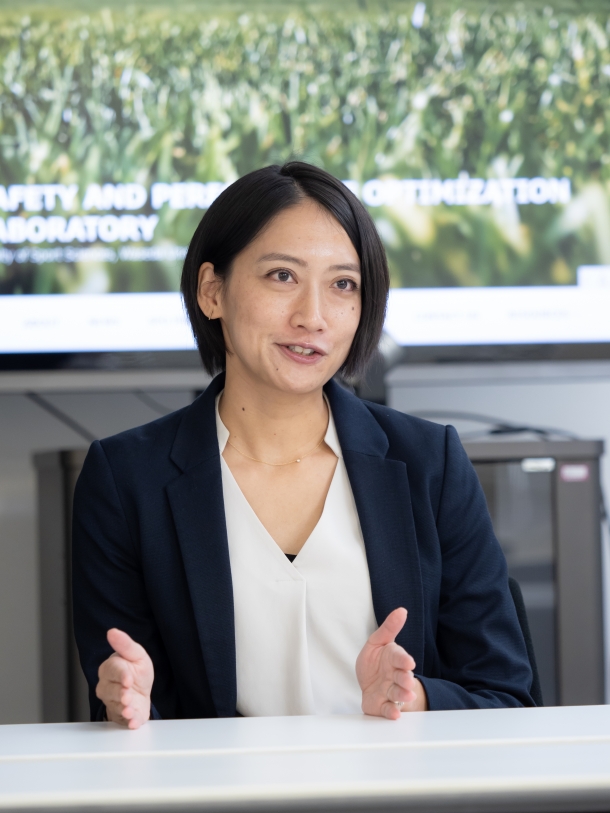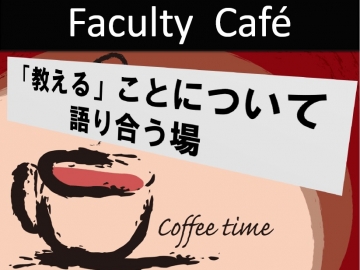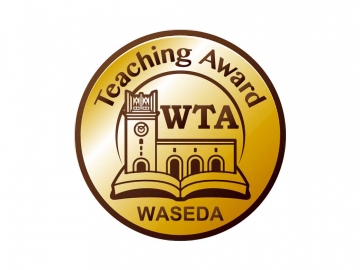WasedaX
Vice President of Academic Affairs and Personnel Affairs Suga and Dr. Hosokawa
(New Course) Sport Safety: A Guide to Preventing Sudden Death in Sport
Since September 2015, Waseda University has been using edX (founded by Harvard University and MIT in the U.S.), a provider of Massive Open Online Courses (MOOC), to deliver a wide variety of courses to a worldwide audience.
Associate Professor Yuri Hosokawa of the Faculty of Sport Sciences, who specializes in athletic training, will teach a new course starting this spring, titled “Sport Safety: A Guide to Preventing Sudden Death in Sport”. Vice President Koichi Suga spoke with Dr. Hosokawa on the goals of this course, which focuses on the prevention of sports-related sudden deaths.
Lives can be saved by researchers’ evidence
Vice President Suga:Dr. Hosokawa, I understand that you were involved in last year’s Tokyo Olympic and Paralympic Games. What are some of the greatest appeals of being being a researcher in this field?
Dr. Hosokawa:I originally studied abroad in the U.S. to become an athletic trainer to support athletes. However, I decided to become a researcher when I learned that researchers could also contribute to saving lives of athletes by publishing scientific evidence that supports athletic trainers to focus on their work with confidence. In Japan, there was a lack of evidence related to management of sports-related heat stroke, so at the Tokyo Olympic and Paralympic Games, I provided guidance to the organizing committee by reformatting the guidelines from the U.S. to fit the Japanese medical system. Even though I am only a researcher, I find it very rewarding to be able to make contributions by providing research findings that are widely used and applied by clinical professionals. If a paradigm shift occurs as a result of research, it can lead to an investment of time and money in safety standards. It is a great pleasure for me as a researcher to be able to lay the foundation for the benefit of many people.
“My goal is for everyone involved in sports to be aware of and know about safety”
Vice President Suga:I assume that this course is filled with your experiences and thoughts. Can you tell me about its contents?
Dr. Hosokawa:In order to prevent sudden death in sport, it is necessary to raise awareness in the field and ensure that life-saving measures can be taken in the event of a dangerous event. To make this a reality, I would like to present an idea that all stakeholders of sports, including not only the medical staff but also coaches, athletes, organizations, and others also share the sense of awareness in promoting safety.
This course is organized into four weeks. First, as an overview, we will look at a variety of scientifically based frameworks of what each of us can do to ensure safety in sports. This is a conceptual overview of where the dangers are and the most efficient means of addressing them. Then, we will move on to more detailed discussions. We will address the three major causes of sudden deaths in sports that account for 70 to 80% of all reported cases: cardiac arrest, exertional heatstroke, and head and neck trauma.
At the end of each week, a progress check will be given on specific actions related to sports safety. Participants will take what they have learned and check their level of achievement in their respective fields. Rather than just answer yes or no, participants will do a self-evaluation on how well they think they are doing and how confident they are. Through this process, I hope to trigger the participants to think, “What changes should be made in the future?” and encourage them to take action by outlining the expected processes that need to be addressed before and during implementation.
Promoting Waseda as a center for sports safety
Vice President Suga:You are now distributing your courses through edX. What do you feel is the significance of sending them from Waseda to the world?
Dr. Hosokawa:There is a sense that much of the work on athletic training is currently concentrated in the U.S., so I would like to highlight the novelty of this kind of initiative in Japan.
In the course, I will cite examples from the U.S., but I am conscious to make sure that the information can be applied in any country or region. Laboratories specializing in sports safety are actually quite rare in the world, and I would like to use this course as a great opportunity to promote Waseda’s School of Sport Sciences as one such place.
Vice President Suga:Safety is such an important factor, but I am surprised that there are so few researchers in this field.
Dr. Hosokawa:Even though we know the importance of safety, quantifying the value of “I am glad I was able to play sports safely” is difficult. Unfortunately, there is a negative cycle where proactive safety action is not taken until after a problem occurs.
However, just as disaster drills and earthquake preparedness have become widespread among the general public, I expect many changes to happen if sports safety becomes a matter that people are naturally aware of. I would be more than happy if the content presented in this lecture becomes part of the basic knowledge that people involved in sports must know.
Looking at sports from the perspective of safety has the potential to connect with diverse fields
Vice President Suga:Finally, do you have a message for those who wish to take this course?
Dr. Hosokawa:First of all, I would like to encourage anyone who is involved in sports, whether as a coach, athlete, or those who aspire to become a coach, to take this course. In the course I am currently teaching in the School of Sport Sciences, students from business majors and other liberal arts majors are also participating. By looking at sports, a familiar topic, from the novel perspective of “safety”, these students are discovering overlaps with their own expertise and coming up with ideas they have never had before. I believe that this course will open a new perspective on how to look at sports and can be applied to various fields.
The field of athletic training is still in its developing stages in Japan, but it is expected to play an active role in the future in a variety of settings, such as supporting the health of the elderly and the promotion of physical activities among children. Injury and accident prevention during sports activities is an area that has not received much attention in the traditional medical profession, so I would like to spread the message that “athletic training will lead sports safety”.
Vice President Suga:As a university, we believe that we should actively promote the development of new research. It is wonderful to have young researchers like Dr. Hosokawa actively disseminating information. I am looking forward to it.
Click here for the course outline and registration
https://www.edx.org/course/waseda-sport-safety








